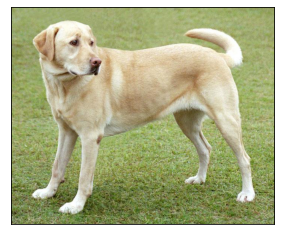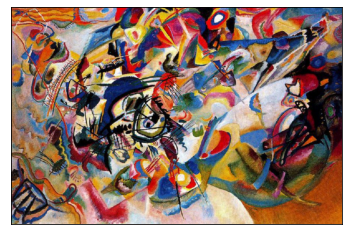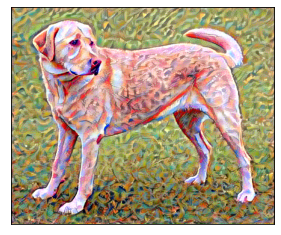使用 TensorFlow 进行神经风格迁移
神经风格转移是一种优化技术,用于获取两个图像,一个内容图像和一个风格参考图像(例如著名画家的作品),并将它们混合在一起,使输出图像看起来像内容图像,但“绘画”在样式参考图像的样式中。 Prisma 、 DreamScope 、 PicsArt等许多流行的 Android iOS 应用程序都使用了这种技术。
风格转移的一个例子 A 是内容图像,B 是输出,左下角有风格图像
架构:
神经风格迁移论文使用 VGG-19 网络的中间层生成的特征图来生成输出图像。该架构将风格和内容图像作为输入,并存储由 VGG 网络的卷积层提取的特征。

VGG-19 架构
内容丢失:
为了计算内容成本,当我们传递生成的图像和原始图像时,我们应用内容层生成的矩阵之间的均方差。设p和x是原始图像和生成的图像, P 和 F 是它们各自在第l层的特征表示。然后我们定义两个特征表示之间的平方误差损失

风格损失:
要计算样式成本,我们将首先计算 gram 矩阵。 gram 矩阵计算涉及计算特定层的矢量化特征图之间的内积。这里 G ij (l) 表示第 l 层的向量化特征 i,j 之间的内积。 ![]()
现在要计算特定的损失,我们将找到根据风格图像和生成图像的特征向量计算的 gram 矩阵的均方差。然后将其加权到层加权因子。
设 a 和 x 是原始图像和生成图像,Al 和 Gl 分别是第 l 层中的样式表示(gram 矩阵)。那么第 l 层对总损失的贡献为: 
因此,总风格损失将是: ![]()
总体损耗
总损失是我们上面定义的样式和内容损失的线性组合: ![]()
其中α和β分别是内容和风格重建的权重因子。
TensorFlow 中的实现:
- 首先,我们导入必要的模块。在这篇文章中,我们将 TensorFlow v2 与 Keras 结合使用。我们还将从 tf.keras API 导入 VGG-19 模型。
代码:
Python3
# import numpy, tensorflow and matplotlib
import tensorflow as tf
import numpy as np
import matplotlib.pyplot as plt
# import VGG 19 model and keras Model API
from tensorflow.python.keras.applications.vgg19 import VGG19, preprocess_input
from tensorflow.python.keras.preprocessing.image import load_img, img_to_array
from tensorflow.python.keras.models import ModelPython3
# Image Credits: Tensorflow Doc
content_path = tf.keras.utils.get_file('content.jpg',
'https://storage.googleapis.com/download.tensorflow.org/example_images/YellowLabradorLooking_new.jpg')
style_path = tf.keras.utils.get_file('style.jpg',
'https://storage.googleapis.com/download.tensorflow.org/example_images/Vassily_Kandinsky%2C_1913_-_Composition_7.jpg')Python3
# code
# this function download the VGG model and initialise it
model = VGG19(
include_top=False,
weights='imagenet'
)
# set training to False
model.trainable = False
# Print details of different layers
model.summary()Python3
# code to load and process image
def load_and_process_image(image_path):
img = load_img(image_path)
# convert image to array
img = img_to_array(img)
img = preprocess_input(img)
img = np.expand_dims(img, axis=0)
return imgPython3
# code
def deprocess(img):
# perform the inverse of the pre processing step
img[:, :, 0] += 103.939
img[:, :, 1] += 116.779
img[:, :, 2] += 123.68
# convert RGB to BGR
img = img[:, :, ::-1]
img = np.clip(img, 0, 255).astype('uint8')
return img
def display_image(image):
# remove one dimension if image has 4 dimension
if len(image.shape) == 4:
img = np.squeeze(image, axis=0)
img = deprocess(img)
plt.grid(False)
plt.xticks([])
plt.yticks([])
plt.imshow(img)
returnPython3
# load content image
content_img = load_and_process_image(content_path)
display_image(content_img)
# load style image
style_img = load_and_process_image(style_path)
display_image(style_img)Python3
# define content model
content_layer = 'block5_conv2'
content_model = Model(
inputs=model.input,
outputs=model.get_layer(content_layer).output
)
content_model.summary()Python3
# define style model
style_layers = [
'block1_conv1',
'block3_conv1',
'block5_conv1'
]
style_models = [Model(inputs=model.input,
outputs=model.get_layer(layer).output) for layer in style_layers]Python3
# Content loss
def content_loss(content, generated):
a_C = content_model(content)
loss = tf.reduce_mean(tf.square(a_C - a_G))
return lossPython3
# gram matrix
def gram_matrix(A):
channels = int(A.shape[-1])
a = tf.reshape(A, [-1, channels])
n = tf.shape(a)[0]
gram = tf.matmul(a, a, transpose_a=True)
return gram / tf.cast(n, tf.float32)
weight_of_layer = 1. / len(style_models)
# style loss
def style_cost(style, generated):
J_style = 0
for style_model in style_models:
a_S = style_model(style)
a_G = style_model(generated)
GS = gram_matrix(a_S)
GG = gram_matrix(a_G)
current_cost = tf.reduce_mean(tf.square(GS - GG))
J_style += current_cost * weight_of_layer
return J_stylePython3
# training function
generated_images = []
def training_loop(content_path, style_path, iterations=50, a=10, b=1000):
# load content and style images from their respective path
content = load_and_process_image(content_path)
style = load_and_process_image(style_path)
generated = tf.Variable(content, dtype=tf.float32)
opt = tf.keras.optimizers.Adam(learning_rate=7)
best_cost = Inf
best_image = None
for i in range(iterations):
% % time
with tf.GradientTape() as tape:
J_content = content_cost(content, generated)
J_style = style_cost(style, generated)
J_total = a * J_content + b * J_style
grads = tape.gradient(J_total, generated)
opt.apply_gradients([(grads, generated)])
if J_total < best_cost:
best_cost = J_total
best_image = generated.numpy()
print("Iteration :{}".format(i))
print('Total Loss {:e}.'.format(J_total))
generated_images.append(generated.numpy())
return best_imagePython3
# Train the model and get best image
final_img = training(content_path, style_path)Python3
# code to display best generated image and last 10 intermediate results
plt.figure(figsize=(12, 12))
for i in range(10):
plt.subplot(4, 3, i + 1)
display_image(generated_images[i+39])
plt.show()
# plot best result
display_image(final_img)- 现在,我们导入内容和样式图像并将它们保存到我们的工作目录中。
代码:
Python3
# Image Credits: Tensorflow Doc
content_path = tf.keras.utils.get_file('content.jpg',
'https://storage.googleapis.com/download.tensorflow.org/example_images/YellowLabradorLooking_new.jpg')
style_path = tf.keras.utils.get_file('style.jpg',
'https://storage.googleapis.com/download.tensorflow.org/example_images/Vassily_Kandinsky%2C_1913_-_Composition_7.jpg')
- 现在,我们使用 ImageNet 权重初始化 VGG 模型,我们还将移除顶层并使其不可训练。
代码:
Python3
# code
# this function download the VGG model and initialise it
model = VGG19(
include_top=False,
weights='imagenet'
)
# set training to False
model.trainable = False
# Print details of different layers
model.summary()
输出:
Downloading data from https://storage.googleapis.com/tensorflow/keras-applications/vgg19/vgg19_weights_tf_dim_ordering_tf_kernels_notop.h5
80142336/80134624 [==============================] - 1s 0us/step
Model: "vgg19"
_________________________________________________________________
Layer (type) Output Shape Param #
=================================================================
input_1 (InputLayer) [(None, None, None, 3)] 0
_________________________________________________________________
block1_conv1 (Conv2D) (None, None, None, 64) 1792
_________________________________________________________________
block1_conv2 (Conv2D) (None, None, None, 64) 36928
_________________________________________________________________
block1_pool (MaxPooling2D) (None, None, None, 64) 0
_________________________________________________________________
block2_conv1 (Conv2D) (None, None, None, 128) 73856
_________________________________________________________________
block2_conv2 (Conv2D) (None, None, None, 128) 147584
_________________________________________________________________
block2_pool (MaxPooling2D) (None, None, None, 128) 0
_________________________________________________________________
block3_conv1 (Conv2D) (None, None, None, 256) 295168
_________________________________________________________________
block3_conv2 (Conv2D) (None, None, None, 256) 590080
_________________________________________________________________
block3_conv3 (Conv2D) (None, None, None, 256) 590080
_________________________________________________________________
block3_conv4 (Conv2D) (None, None, None, 256) 590080
_________________________________________________________________
block3_pool (MaxPooling2D) (None, None, None, 256) 0
_________________________________________________________________
block4_conv1 (Conv2D) (None, None, None, 512) 1180160
_________________________________________________________________
block4_conv2 (Conv2D) (None, None, None, 512) 2359808
_________________________________________________________________
block4_conv3 (Conv2D) (None, None, None, 512) 2359808
_________________________________________________________________
block4_conv4 (Conv2D) (None, None, None, 512) 2359808
_________________________________________________________________
block4_pool (MaxPooling2D) (None, None, None, 512) 0
_________________________________________________________________
block5_conv1 (Conv2D) (None, None, None, 512) 2359808
_________________________________________________________________
block5_conv2 (Conv2D) (None, None, None, 512) 2359808
_________________________________________________________________
block5_conv3 (Conv2D) (None, None, None, 512) 2359808
_________________________________________________________________
block5_conv4 (Conv2D) (None, None, None, 512) 2359808
_________________________________________________________________
block5_pool (MaxPooling2D) (None, None, None, 512) 0
=================================================================
Total params: 20,024,384
Trainable params: 0
Non-trainable params: 20,024,384
________________________________________________________________- 现在,我们使用 VGG 19 中的 Keras 预处理输入来加载和处理图像。expand_dims函数添加了一个维度来表示输入中的多个图像。这个preprocess_input函数(在 VGG 19 中使用)将输入 RGB 转换为 BGR 图像,并根据 ImageNet 数据将这些值集中在 0 附近(无缩放)。
代码:
Python3
# code to load and process image
def load_and_process_image(image_path):
img = load_img(image_path)
# convert image to array
img = img_to_array(img)
img = preprocess_input(img)
img = np.expand_dims(img, axis=0)
return img
- 现在,我们定义了接受输入图像的deprocess函数,并执行我们上面导入的preprocess_input函数的逆操作。为了显示未处理的图像,我们还定义了一个显示函数。
代码:
Python3
# code
def deprocess(img):
# perform the inverse of the pre processing step
img[:, :, 0] += 103.939
img[:, :, 1] += 116.779
img[:, :, 2] += 123.68
# convert RGB to BGR
img = img[:, :, ::-1]
img = np.clip(img, 0, 255).astype('uint8')
return img
def display_image(image):
# remove one dimension if image has 4 dimension
if len(image.shape) == 4:
img = np.squeeze(image, axis=0)
img = deprocess(img)
plt.grid(False)
plt.xticks([])
plt.yticks([])
plt.imshow(img)
return
- 现在,我们使用上面的函数来显示样式和内容图像
代码:
Python3
# load content image
content_img = load_and_process_image(content_path)
display_image(content_img)
# load style image
style_img = load_and_process_image(style_path)
display_image(style_img)
输出:

内容图片

风格形象
- 现在,我们使用 Keras.Model API 定义内容和样式模型。内容模型将图像作为输入,并从上述 VGG 模型的“block5_conv1”中输出特征图。
代码:
Python3
# define content model
content_layer = 'block5_conv2'
content_model = Model(
inputs=model.input,
outputs=model.get_layer(content_layer).output
)
content_model.summary()
输出:
Model: "functional_9"
_________________________________________________________________
Layer (type) Output Shape Param #
=================================================================
input_1 (InputLayer) [(None, None, None, 3)] 0
_________________________________________________________________
block1_conv1 (Conv2D) (None, None, None, 64) 1792
_________________________________________________________________
block1_conv2 (Conv2D) (None, None, None, 64) 36928
_________________________________________________________________
block1_pool (MaxPooling2D) (None, None, None, 64) 0
_________________________________________________________________
block2_conv1 (Conv2D) (None, None, None, 128) 73856
_________________________________________________________________
block2_conv2 (Conv2D) (None, None, None, 128) 147584
_________________________________________________________________
block2_pool (MaxPooling2D) (None, None, None, 128) 0
_________________________________________________________________
block3_conv1 (Conv2D) (None, None, None, 256) 295168
_________________________________________________________________
block3_conv2 (Conv2D) (None, None, None, 256) 590080
_________________________________________________________________
block3_conv3 (Conv2D) (None, None, None, 256) 590080
_________________________________________________________________
block3_conv4 (Conv2D) (None, None, None, 256) 590080
_________________________________________________________________
block3_pool (MaxPooling2D) (None, None, None, 256) 0
_________________________________________________________________
block4_conv1 (Conv2D) (None, None, None, 512) 1180160
_________________________________________________________________
block4_conv2 (Conv2D) (None, None, None, 512) 2359808
_________________________________________________________________
block4_conv3 (Conv2D) (None, None, None, 512) 2359808
_________________________________________________________________
block4_conv4 (Conv2D) (None, None, None, 512) 2359808
_________________________________________________________________
block4_pool (MaxPooling2D) (None, None, None, 512) 0
_________________________________________________________________
block5_conv1 (Conv2D) (None, None, None, 512) 2359808
_________________________________________________________________
block5_conv2 (Conv2D) (None, None, None, 512) 2359808
=================================================================
Total params: 15,304,768
Trainable params: 0
Non-trainable params: 15,304,768
_________________________________________________________________- 现在,我们使用 Keras.Model API 定义内容和样式模型。样式模型将图像作为输入,并从上述 VGG 模型的“block1_conv1、block3_conv1和 block5_conv2”中输出特征图。
代码:
Python3
# define style model
style_layers = [
'block1_conv1',
'block3_conv1',
'block5_conv1'
]
style_models = [Model(inputs=model.input,
outputs=model.get_layer(layer).output) for layer in style_layers]
- 现在,我们定义内容损失函数,它将获取生成图像和真实图像的特征图并计算它们之间的均方差。
代码:
Python3
# Content loss
def content_loss(content, generated):
a_C = content_model(content)
loss = tf.reduce_mean(tf.square(a_C - a_G))
return loss
- 现在,我们定义了 gram 矩阵和风格损失函数。该函数还将真实和生成的图像作为模型的输入,计算它们的 gram 矩阵,然后计算加权到不同层的样式损失。
代码:
Python3
# gram matrix
def gram_matrix(A):
channels = int(A.shape[-1])
a = tf.reshape(A, [-1, channels])
n = tf.shape(a)[0]
gram = tf.matmul(a, a, transpose_a=True)
return gram / tf.cast(n, tf.float32)
weight_of_layer = 1. / len(style_models)
# style loss
def style_cost(style, generated):
J_style = 0
for style_model in style_models:
a_S = style_model(style)
a_G = style_model(generated)
GS = gram_matrix(a_S)
GG = gram_matrix(a_G)
current_cost = tf.reduce_mean(tf.square(GS - GG))
J_style += current_cost * weight_of_layer
return J_style
- 现在,我们定义我们的训练函数,我们将训练我们的模型进行 50 次迭代。该模型将输入图像、迭代次数作为其参数。
Python3
# training function
generated_images = []
def training_loop(content_path, style_path, iterations=50, a=10, b=1000):
# load content and style images from their respective path
content = load_and_process_image(content_path)
style = load_and_process_image(style_path)
generated = tf.Variable(content, dtype=tf.float32)
opt = tf.keras.optimizers.Adam(learning_rate=7)
best_cost = Inf
best_image = None
for i in range(iterations):
% % time
with tf.GradientTape() as tape:
J_content = content_cost(content, generated)
J_style = style_cost(style, generated)
J_total = a * J_content + b * J_style
grads = tape.gradient(J_total, generated)
opt.apply_gradients([(grads, generated)])
if J_total < best_cost:
best_cost = J_total
best_image = generated.numpy()
print("Iteration :{}".format(i))
print('Total Loss {:e}.'.format(J_total))
generated_images.append(generated.numpy())
return best_image
- 现在,我们使用上面定义的训练函数训练我们的模型。
代码:
Python3
# Train the model and get best image
final_img = training(content_path, style_path)
输出:
CPU times: user 2 µs, sys: 1e+03 ns, total: 3 µs
Wall time: 6.2 µs
Iteration :0
Total Loss 5.133922e+11.
CPU times: user 2 µs, sys: 1e+03 ns, total: 3 µs
Wall time: 5.72 µs
Iteration :1
Total Loss 3.510511e+11.
CPU times: user 2 µs, sys: 1e+03 ns, total: 3 µs
Wall time: 6.68 µs
Iteration :2
Total Loss 2.069992e+11.
CPU times: user 3 µs, sys: 1e+03 ns, total: 4 µs
Wall time: 6.2 µs
Iteration :3
Total Loss 1.669609e+11.
CPU times: user 2 µs, sys: 1e+03 ns, total: 3 µs
Wall time: 6.44 µs
Iteration :4
Total Loss 1.575840e+11.
CPU times: user 2 µs, sys: 1e+03 ns, total: 3 µs
Wall time: 5.96 µs
Iteration :5
Total Loss 1.200623e+11.
CPU times: user 2 µs, sys: 1e+03 ns, total: 3 µs
Wall time: 5.96 µs
Iteration :6
Total Loss 8.824594e+10.
CPU times: user 2 µs, sys: 1e+03 ns, total: 3 µs
Wall time: 5.72 µs
Iteration :7
Total Loss 7.168546e+10.
CPU times: user 2 µs, sys: 1e+03 ns, total: 3 µs
Wall time: 5.48 µs
Iteration :8
Total Loss 6.207320e+10.
CPU times: user 3 µs, sys: 1e+03 ns, total: 4 µs
Wall time: 8.34 µs
Iteration :9
Total Loss 5.390836e+10.
CPU times: user 2 µs, sys: 1e+03 ns, total: 3 µs
Wall time: 6.2 µs
Iteration :10
Total Loss 4.735992e+10.
CPU times: user 2 µs, sys: 1e+03 ns, total: 3 µs
Wall time: 5.96 µs
Iteration :11
Total Loss 4.301782e+10.
CPU times: user 2 µs, sys: 1e+03 ns, total: 3 µs
Wall time: 6.2 µs
Iteration :12
Total Loss 3.912694e+10.
CPU times: user 2 µs, sys: 1e+03 ns, total: 3 µs
Wall time: 6.68 µs
Iteration :13
Total Loss 3.445185e+10.
CPU times: user 0 ns, sys: 3 µs, total: 3 µs
Wall time: 6.2 µs
Iteration :14
Total Loss 2.975165e+10.
CPU times: user 2 µs, sys: 0 ns, total: 2 µs
Wall time: 5.96 µs
Iteration :15
Total Loss 2.590984e+10.
CPU times: user 2 µs, sys: 1e+03 ns, total: 3 µs
Wall time: 20 µs
Iteration :16
Total Loss 2.302116e+10.
CPU times: user 2 µs, sys: 1e+03 ns, total: 3 µs
Wall time: 5.72 µs
Iteration :17
Total Loss 2.082643e+10.
CPU times: user 4 µs, sys: 1e+03 ns, total: 5 µs
Wall time: 8.34 µs
Iteration :18
Total Loss 1.906701e+10.
CPU times: user 2 µs, sys: 1e+03 ns, total: 3 µs
Wall time: 5.25 µs
Iteration :19
Total Loss 1.759801e+10.
CPU times: user 3 µs, sys: 1e+03 ns, total: 4 µs
Wall time: 6.2 µs
Iteration :20
Total Loss 1.635128e+10.
CPU times: user 2 µs, sys: 1e+03 ns, total: 3 µs
Wall time: 6.2 µs
Iteration :21
Total Loss 1.525327e+10.
CPU times: user 3 µs, sys: 1e+03 ns, total: 4 µs
Wall time: 5.96 µs
Iteration :22
Total Loss 1.418364e+10.
CPU times: user 4 µs, sys: 1 µs, total: 5 µs
Wall time: 9.06 µs
Iteration :23
Total Loss 1.306596e+10.
CPU times: user 2 µs, sys: 1e+03 ns, total: 3 µs
Wall time: 5.25 µs
Iteration :24
Total Loss 1.196509e+10.
CPU times: user 2 µs, sys: 1e+03 ns, total: 3 µs
Wall time: 5.96 µs
Iteration :25
Total Loss 1.102290e+10.
CPU times: user 2 µs, sys: 1e+03 ns, total: 3 µs
Wall time: 5.96 µs
Iteration :26
Total Loss 1.025539e+10.
CPU times: user 7 µs, sys: 3 µs, total: 10 µs
Wall time: 12.6 µs
Iteration :27
Total Loss 9.570500e+09.
CPU times: user 2 µs, sys: 1e+03 ns, total: 3 µs
Wall time: 5.72 µs
Iteration :28
Total Loss 8.917115e+09.
CPU times: user 2 µs, sys: 1e+03 ns, total: 3 µs
Wall time: 5.96 µs
Iteration :29
Total Loss 8.328761e+09.
CPU times: user 3 µs, sys: 1e+03 ns, total: 4 µs
Wall time: 9.54 µs
Iteration :30
Total Loss 7.840127e+09.
CPU times: user 2 µs, sys: 1e+03 ns, total: 3 µs
Wall time: 6.44 µs
Iteration :31
Total Loss 7.406647e+09.
CPU times: user 2 µs, sys: 1e+03 ns, total: 3 µs
Wall time: 8.34 µs
Iteration :32
Total Loss 6.967848e+09.
CPU times: user 2 µs, sys: 1e+03 ns, total: 3 µs
Wall time: 5.72 µs
Iteration :33
Total Loss 6.531650e+09.
CPU times: user 2 µs, sys: 1e+03 ns, total: 3 µs
Wall time: 5.72 µs
Iteration :34
Total Loss 6.136975e+09.
CPU times: user 2 µs, sys: 1 µs, total: 3 µs
Wall time: 5.96 µs
Iteration :35
Total Loss 5.788804e+09.
CPU times: user 2 µs, sys: 1e+03 ns, total: 3 µs
Wall time: 5.72 µs
Iteration :36
Total Loss 5.476942e+09.
CPU times: user 2 µs, sys: 1e+03 ns, total: 3 µs
Wall time: 6.2 µs
Iteration :37
Total Loss 5.204070e+09.
CPU times: user 3 µs, sys: 1 µs, total: 4 µs
Wall time: 6.2 µs
Iteration :38
Total Loss 4.954049e+09.
CPU times: user 2 µs, sys: 1e+03 ns, total: 3 µs
Wall time: 5.96 µs
Iteration :39
Total Loss 4.708641e+09.
CPU times: user 3 µs, sys: 2 µs, total: 5 µs
Wall time: 6.2 µs
Iteration :40
Total Loss 4.487677e+09.
CPU times: user 2 µs, sys: 1e+03 ns, total: 3 µs
Wall time: 5.96 µs
Iteration :41
Total Loss 4.296946e+09.
CPU times: user 2 µs, sys: 1e+03 ns, total: 3 µs
Wall time: 5.96 µs
Iteration :42
Total Loss 4.107909e+09.
CPU times: user 3 µs, sys: 1e+03 ns, total: 4 µs
Wall time: 6.44 µs
Iteration :43
Total Loss 3.918156e+09.
CPU times: user 3 µs, sys: 1e+03 ns, total: 4 µs
Wall time: 6.2 µs
Iteration :44
Total Loss 3.747263e+09.
CPU times: user 3 µs, sys: 1e+03 ns, total: 4 µs
Wall time: 8.34 µs
Iteration :45
Total Loss 3.595638e+09.
CPU times: user 2 µs, sys: 1e+03 ns, total: 3 µs
Wall time: 5.72 µs
Iteration :46
Total Loss 3.458928e+09.
CPU times: user 2 µs, sys: 1e+03 ns, total: 3 µs
Wall time: 6.2 µs
Iteration :47
Total Loss 3.331772e+09.
CPU times: user 4 µs, sys: 1e+03 ns, total: 5 µs
Wall time: 9.3 µs
Iteration :48
Total Loss 3.205911e+09.
CPU times: user 3 µs, sys: 1e+03 ns, total: 4 µs
Wall time: 5.96 µs
Iteration :49
Total Loss 3.089630e+09.- 在最后一步,我们绘制最终和中间结果。
代码:
Python3
# code to display best generated image and last 10 intermediate results
plt.figure(figsize=(12, 12))
for i in range(10):
plt.subplot(4, 3, i + 1)
display_image(generated_images[i+39])
plt.show()
# plot best result
display_image(final_img)
输出:
最后 10 个生成的图像

最佳生成图像
参考:
- TensorFlow 神经风格迁移教程
- 风格转移纸